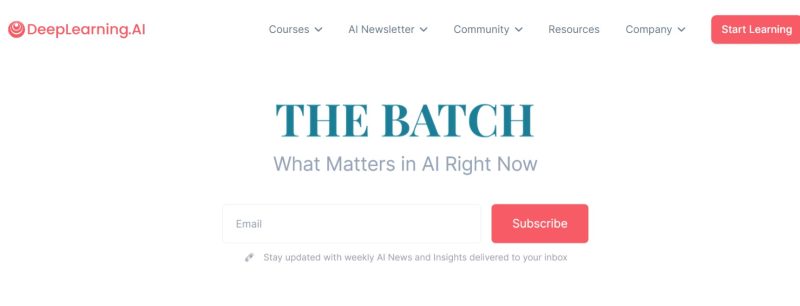You have access to a tool that can change the way you work, learn, and live. A tool that can understand your questions, generate personalized answers, write code, create graphics, and even craft a video of your virtual self that is almost indistinguishable from the real thing. Artificial intelligence, one of the most promising and disruptive technologies of our time, is evolving so rapidly that it is difficult to keep up with its new capabilities. So how do you learn AI to stay up to date? In this article, we’ll take a closer look at the issue and provide practical tips to help you realize the full potential of AI. Read on.
What's going on in the AI world – table of contents
Do you need to know how to code to start using AI?
You don’t have to be a developer to start being in AI world. Thanks to advances in machine learning and the development of no-code AI, the use of advanced AI tools is now available to anyone, regardless of technical skills.
From ChatGPT (https://chat.openai.com/), which can write an essay or generate code for you, to HeyGen (https://www.heygen.com/), which can generate videos of your virtual self, to Midjourney (https://www.midjourney.com/), which can create images, AI tools can greatly assist you in your work without programming. You don’t have to wrestle with lines of code – all you have to do is skillfully type in your request, and AI takes care of the rest.
Of course, being familiar with the basics of programming and machine learning, and especially the basics of generative artificial intelligence, can be useful if you want to deepen your knowledge or create more advanced AI applications. It will give you a better understanding of how these tools work and how to use them to their full potential. For now, though, you can simply enjoy the ease and freedom of using them without having to spend years learning to code.
Where to get up-to-date information from the AI world?
With AI evolving at such a rapid pace, staying on top of the latest trends and discoveries can seem daunting. Fortunately, there are a number of information resources available to help you stay ahead of the curve. One such resource is the AI series on the IFIRMA website (https://www.ifirma.pl/kategoria/blog/ai/ai-w-biznesie). Regularly published articles provide valuable information on AI applications in business, as well as tips on how to implement these technologies in your organization.
The key, however, is to skillfully combine sources and regularly update your knowledge. It makes sense to start with educational materials from leading players in the AI market, such as Google, OpenAI, and DeepMind. Online courses, webinars, and step-by-step guides will give you a solid theoretical foundation and practical skills for using AI tools. Try out:
- AI basics on aihero.pl (https://www.aihero.pl/kursy/podstawy-pracy-z-ai) – this free AI course is a solid starter if you’re just beginning to use AI tools,
- Introduction to Generative AI Learning Path from Google (https://www.cloudskillsboost.google/paths/118) is an overview of generative AI concepts, from the basics of large language models to the principles of responsible AI,
- Generative AI for Everyone from Deeplearning.ai (https://www.deeplearning.ai/courses/generative-ai-for-everyone/) teaches how generative AI works and how to use it in everyday life and at work.

Source: Deeplearning.ai (https://www.deeplearning.ai/courses/generative-ai-for-everyone/)
Podcasts are a great way to explore AI topics in an accessible format. Here are a few suggestions worth checking out:
- 99 shades of AI” (https://www.99twarzyai.pl/category/podcast/) – a podcast hosted by Karol Stryja in which experts, researchers, and practitioners share their experiences and insights on AI,
- ”Understanding AI” (https://businessinsider.com.pl/zrozumiec-ai) – a series of podcasts and articles covering AI topics from basic concepts to applications in various fields.
Signing up for newsletters dedicated to AI is also a great way to get regular doses of up-to-date information and interesting facts. Two particularly valuable examples are:
- „The Batch” from DeepLearning.AI (https://www.deeplearning.ai/the-batch/) – a weekly newsletter providing news and insights from the world of AI, designed for both beginners and experts,
- „The Neuron” (https://www.theneurondaily.com/subscribe) – a newsletter showcasing the latest developments and trends in AI along with practical tips and tools from experts.

Source: Deeplearning.ai (https://www.deeplearning.ai/the-batch/)
In addition, it is worth following the blogs and social media of AI experts, such as Aleksandra Przegalińska, Wlodzislaw Duch or Adam Gospodarczyk and Grzegorz Róg. They share their insights, analyses and forecasts on AI development, which can be a valuable source of inspiration and knowledge.
We should also not forget about traditional methods of finding information, such as browsing books and scientific articles, for example on ArXiv (https://arxiv.org/). While these may not be as up-to-date as blogs or social media, they provide a much deeper understanding of the concepts and theories behind AI, which is crucial for a deeper understanding of the field.
Although the sources we recommend above are very valuable, they represent only a fraction of the interesting news related to AI. If you are looking for inspiration, pay attention to the reputation of the authors, the timeliness of the content, and the support of the theses presented with concrete examples and data. A critical approach will allow you to avoid the misinformation that often accompanies this popular topic and to form an accurate picture of the state of knowledge in the field of AI. But now it’s time for tools – how to start learning AI practically?
Is it worth trying out all the tools one by one? Or is it better to learn two of them well?
In the world of AI, where exciting new tools appear almost daily, it is easy to be tempted to try them all out one by one. But is this approach effective? Maybe it’s better to focus on mastering a few key solutions that best fit your needs and goals?
Consider the following arguments for a selective approach to learning AI tools:
- Saving time and energy. If you try every new tool that comes out, you risk diverting your attention and energy. Instead of wasting valuable time learning how to use dozens of applications, it’s better to focus on gaining a thorough understanding of the ones that are most relevant to you. In this way, you’ll become proficient more quickly and reap real benefits from using them.
- Increased efficiency and productivity. The better you master a given AI tool, the more efficiently you can use it in your work. Knowing all of its features and nuances will help you complete your tasks faster and more efficiently. This, in turn, translates into higher productivity and better results.
- Consistency and predictability. By using the same tools consistently, you can develop a systematic and uniform style of work. Its results will be more uniform and easier to control, which is especially important for long-term projects or collaborations with others.
- Optimizing processes and integrating AI into daily work. By focusing on a few key tools, you can optimize your work and seamlessly integrate AI into your daily tasks. This will make AI a natural extension of your skills, rather than an additional burden.
- Saving money. Many AI tools operate on a subscription model or require user fees. Typically, the amount for monthly access starts around $20 (80 zlotys) plus tax. By limiting the number of applications you use, you can save a lot of money and better control your budget for new technologies.
Of course, this does not mean that you should give up experimenting with new tools altogether. On the contrary, it’s a good idea to regularly browse the available options, for example at There’s An AI for That (https://theresanaiforthat.com/), in search of innovative solutions that can improve your work. More than 13,000 tools are already there!
So before you make a decision, think about what your key needs and goals are. Find the tools that best meet them and test them. If they prove useful, gradually add them to your toolkit, while ensuring that the number of active applications remains within reasonable limits. This approach will allow you to take advantage of advances in AI while maintaining focus and efficiency.

Source: DALL·E 3, prompt: Marta M. Kania (https://www.linkedin.com/in/martamatyldakania/)
Do you really need to be up to date with AI world?
Technological progress seems to be accelerating every day. For many, the pace of change can be frustrating, so they question the need to keep up with AI developments. Isn’t it enough to just focus on your work and wait for the revolution to come to you?
If you want to stay competitive and realize the potential of artificial intelligence, you can’t bury your head in the sand. While you don’t need to follow every update, understanding the potential and capabilities of these technologies is essential. Let’s look at some of the key reasons why you need to keep up with AI:
- AI is changing dynamically – unfortunately, in business it is impossible to stand still, especially as companies are creating a gap between themselves and their competitors faster than ever before. In other words, if you don’t try to keep up with AI developments, you risk making your skills and knowledge obsolete,
- AI is no longer just another IT tool – is a true transformation, comparable to the invention of the Internet or the development of the word processor. Over the next few years, AI will change the way we work, learn, and communicate, becoming an integral part of our professional and personal lives.
Imagine having a virtual assistant to help you write reports, create presentations, and even code. Imagine being able to use a sophisticated data analysis tool that can instantly extract key insights from vast collections of information. This is not the distant future – these capabilities already exist thanks to AI.

Źródło: DALL·E 3, prompt: Marta M. Kania (https://www.linkedin.com/in/martamatyldakania/)
Summary
Artificial intelligence is a technology that is changing the face of the modern world. Its influence extends to almost every aspect of life, from business to education to entertainment. With such a dynamic development, it is important to constantly update your knowledge and skills in using AI tools.
Understanding how these tools work and how to use them will not only make you more productive, but also open the door to new opportunities and innovations. But remember, learning AI doesn’t have to be overwhelming. You can start with small steps and gradually increase your involvement.
Here are some practical tips for incorporating AI learning into your daily routine:
- Subscribe to an AI newsletter or news channel to get regular updates.
- Set aside a weekly “AI time,” an hour or two to read articles, watch webinars, or try out new tools.
- Join the AI community on platforms like Reddit, Discord, and Slack, where you can discuss and learn from other enthusiasts.
- Pay particular attention to AI trends that may affect your industry or profession. These could include recommendation systems for e-commerce, chatbots for customer service, or business process automation tools.
Remember, AI is more than a tool-it’s a new way of thinking and solving problems. The sooner you get comfortable with it, the easier it will be for you to adapt to the coming changes and reap the benefits of this disruptive technology. Be curious and willing to learn – that is the key to success in the AI era.

If you like our content, join our busy bees community on Facebook, Twitter, LinkedIn, Instagram, YouTube, Pinterest, TikTok.
Author: Robert Whitney
JavaScript expert and instructor who coaches IT departments. His main goal is to up-level team productivity by teaching others how to effectively cooperate while coding.
AI in business:
- Threats and opportunities of AI in business (part 1)
- Threats and opportunities of AI in business (part 2)
- AI applications in business - overview
- AI-assisted text chatbots
- Business NLP today and tomorrow
- The role of AI in business decision-making
- Scheduling social media posts. How can AI help?
- Automated social media posts
- New services and products operating with AI
- What are the weaknesses of my business idea? A brainstorming session with ChatGPT
- Using ChatGPT in business
- Synthetic actors. Top 3 AI video generators
- 3 useful AI graphic design tools. Generative AI in business
- 3 awesome AI writers you must try out today
- Exploring the power of AI in music creation
- Navigating new business opportunities with ChatGPT-4
- AI tools for the manager
- 6 awesome ChatGTP plugins that will make your life easier
- 3 grafików AI. Generatywna sztuczna inteligencja dla biznesu
- What is the future of AI according to McKinsey Global Institute?
- Artificial intelligence in business - Introduction
- What is NLP, or natural language processing in business
- Automatic document processing
- Google Translate vs DeepL. 5 applications of machine translation for business
- The operation and business applications of voicebots
- Virtual assistant technology, or how to talk to AI?
- What is Business Intelligence?
- Will artificial intelligence replace business analysts?
- How can artificial intelligence help with BPM?
- AI and social media – what do they say about us?
- Artificial intelligence in content management
- Creative AI of today and tomorrow
- Multimodal AI and its applications in business
- New interactions. How is AI changing the way we operate devices?
- RPA and APIs in a digital company
- The future job market and upcoming professions
- AI in EdTech. 3 examples of companies that used the potential of artificial intelligence
- Artificial intelligence and the environment. 3 AI solutions to help you build a sustainable business
- AI content detectors. Are they worth it?
- ChatGPT vs Bard vs Bing. Which AI chatbot is leading the race?
- Is chatbot AI a competitor to Google search?
- Effective ChatGPT Prompts for HR and Recruitment
- Prompt engineering. What does a prompt engineer do?
- AI Mockup generator. Top 4 tools
- AI and what else? Top technology trends for business in 2024
- AI and business ethics. Why you should invest in ethical solutions
- Meta AI. What should you know about Facebook and Instagram's AI-supported features?
- AI regulation. What do you need to know as an entrepreneur?
- 5 new uses of AI in business
- AI products and projects - how are they different from others?
- AI-assisted process automation. Where to start?
- How do you match an AI solution to a business problem?
- AI as an expert on your team
- AI team vs. division of roles
- How to choose a career field in AI?
- Is it always worth it to add artificial intelligence to the product development process?
- AI in HR: How recruitment automation affects HR and team development
- 6 most interesting AI tools in 2023
- 6 biggest business mishaps caused by AI
- What is the company's AI maturity analysis?
- AI for B2B personalization
- ChatGPT use cases. 18 examples of how to improve your business with ChatGPT in 2024
- Microlearning. A quick way to get new skills
- The most interesting AI implementations in companies in 2024
- What do artificial intelligence specialists do?
- What challenges does the AI project bring?
- Top 8 AI tools for business in 2024
- AI in CRM. What does AI change in CRM tools?
- The UE AI Act. How does Europe regulate the use of artificial intelligence
- Sora. How will realistic videos from OpenAI change business?
- Top 7 AI website builders
- No-code tools and AI innovations
- How much does using AI increase the productivity of your team?
- How to use ChatGTP for market research?
- How to broaden the reach of your AI marketing campaign?
- "We are all developers". How can citizen developers help your company?
- AI in transportation and logistics
- What business pain points can AI fix?
- Artificial intelligence in the media
- AI in banking and finance. Stripe, Monzo, and Grab
- AI in the travel industry
- How AI is fostering the birth of new technologies
- The revolution of AI in social media
- AI in e-commerce. Overview of global leaders
- Top 4 AI image creation tools
- Top 5 AI tools for data analysis
- AI strategy in your company - how to build it?
- Best AI courses – 6 awesome recommendations
- Optimizing social media listening with AI tools
- IoT + AI, or how to reduce energy costs in a company
- AI in logistics. 5 best tools
- GPT Store – an overview of the most interesting GPTs for business
- LLM, GPT, RAG... What do AI acronyms mean?
- AI robots – the future or present of business?
- What is the cost of implementing AI in a company?
- How can AI help in a freelancer’s career?
- Automating work and increasing productivity. A guide to AI for freelancers
- AI for startups – best tools
- Building a website with AI
- OpenAI, Midjourney, Anthropic, Hugging Face. Who is who in the world of AI?
- Eleven Labs and what else? The most promising AI startups
- Synthetic data and its importance for the development of your business
- Top AI search engines. Where to look for AI tools?
- Video AI. The latest AI video generators
- AI for managers. How AI can make your job easier
- What’s new in Google Gemini? Everything you need to know
- AI in Poland. Companies, meetings, and conferences
- AI calendar. How to optimize your time in a company?
- AI and the future of work. How to prepare your business for change?
- AI voice cloning for business. How to create personalized voice messages with AI?
- Fact-checking and AI hallucinations
- AI in recruitment – developing recruitment materials step-by-step
- Midjourney v6. Innovations in AI image generation
- AI in SMEs. How can SMEs compete with giants using AI?
- How is AI changing influencer marketing?
- Is AI really a threat to developers? Devin and Microsoft AutoDev
- AI chatbots for e-commerce. Case studies
- Best AI chatbots for ecommerce. Platforms
- How to stay on top of what's going on in the AI world?
- Taming AI. How to take the first steps to apply AI in your business?
- Perplexity, Bing Copilot, or You.com? Comparing AI search engines
- ReALM. A groundbreaking language model from Apple?
- AI experts in Poland
- Google Genie — a generative AI model that creates fully interactive worlds from images
- Automation or augmentation? Two approaches to AI in a company
- LLMOps, or how to effectively manage language models in an organization
- AI video generation. New horizons in video content production for businesses
- Best AI transcription tools. How to transform long recordings into concise summaries?
- Sentiment analysis with AI. How does it help drive change in business?
- The role of AI in content moderation


















